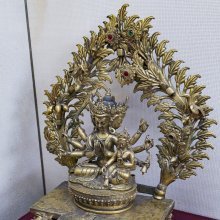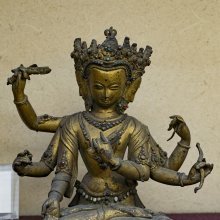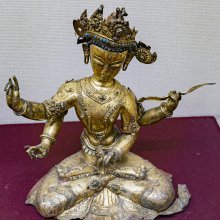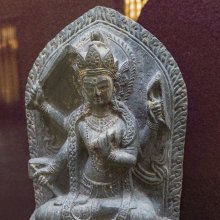Manjushri, Manjusri, Mañjuśrī, Manju-shri: 15 definitions
Introduction:
Manjushri means something in Buddhism, Pali, Hinduism, Sanskrit. If you want to know the exact meaning, history, etymology or English translation of this term then check out the descriptions on this page. Add your comment or reference to a book if you want to contribute to this summary article.
The Sanskrit term Mañjuśrī can be transliterated into English as Manjusri or Manjushri, using the IAST transliteration scheme (?).
Images (photo gallery)
(+71 more images available)
In Buddhism
Tibetan Buddhism (Vajrayana or tantric Buddhism)
Source: Wisdom Library: MañjuśrīnāmasaṃgītiMañjuśrī (मञ्जुश्री) is one of the sixteen bodhisattvas appearing in the Vajradhātu-mahāmaṇḍala, according to the Nāmamantrārthāvalokinī v5.38-41. The Nāmamantrārthāvalokinī (literally, ‘an explanation of the nāma-mantras’) is a commentary (ṭīkā) on the 8th century Mañjuśrīnāmasaṃgīti.
Mañjuśrī is a name of Mañjuśrī (the embodiement of non-dual knowledge) and, together with other names, forms the core essence of the Mañjuśrīnāmasaṃgīti. The Nāmamantrārthāvalokinī provides the practitioner a sādhana (‘meditative practice’) to turn these names into mantras. These mantras are chanted for the benefit of all beings, and then placed and contemplated in the Vajradhātu-mahāmaṇḍala, which is an extended version of the Vajradhātu-maṇḍala.
Source: Google Books: Mahāmudrā and Related InstructionsMañjuśrī (मञ्जुश्री) is the name of an ancient teacher belonging to the “lineage of the profound view”, according to “the succession of Gurus in the Mahāmudrā lineages” in the Kagyü School of Tibetan Buddhism (the Mahāmudrā deals with the nature of the mind).—The graduated path of the three levels of beings, which is an adornment [for the Mahāmudrā], is of three lineages: 1. The lineage of vast conduct; 2. The lineage of the profound view; 3. The lineage of the blessing of practice.—[The lineage of vast conduct]—(1) The perfect Buddha, (2) Mañjuśrī,... and (8) Atiśa.
Source: archive.org: The Indian Buddhist IconographyMañjuśrī (मञ्जुश्री) is the name of a Bodhisattva commonly depicted in Buddhist Iconography, and mentioned in the 11th-century Niṣpannayogāvalī of Mahāpaṇḍita Abhayākara.—his color is golden; his symbol is the sword and book.—Like Avalokiteśvara Mañjuśrī is worshipped in all Buddhist countries and has a variety of forms. Mañjuśrī has several names such as Mañjuvajra, Mañjughoṣa, Dharmadhātuvāgīśvara and so forth. Next to Avalokiteśvara, Mañjuśrī is important in the Buddhist pantheon as the God of Learning with the sword for destroying ignorance and the book of transcendental wisdom, His images are numerous, and the Chinese collection presents no less than five different statuettes showing his great popularity in China.
In the Mañjuvajra-maṇḍala Mañjuśrī comes as a Bodhisattva in the third circle of deities surrounding the principal god Mañjuvajra who is represented along with his Prajñā or female counterpart. According to Niṣpannayogāvalī, Mañjuśrī should have the same form as the principal deity but he should have no Prajñā.
Mañjuśrī is described in the Niṣpannayogāvalī as follows:—
“Manjusri is three-faced, with the three faces of yellow, blue and white colour. He is endowed with six arms; in his three right hands he holds the sword, Varada-mudrā and the arrow, and in the three left shows the Prajñāpāramitā book, the blue lotus and the bow”.
Mañjuśrī is sometimes accompanied only by Yamāri, sometimes only by his Śakti or female counterpart, sometimes by Sudhanakumāra and Yamāri and sometimes again by the four divinities, Jālinīprabha (also called Sūryaprabha), Candraprabha, Keśinī and Upakeśinī. Though the last four are required to be present with Arapacana, they are nevertheless found in others also.

Tibetan Buddhism includes schools such as Nyingma, Kadampa, Kagyu and Gelug. Their primary canon of literature is divided in two broad categories: The Kangyur, which consists of Buddha’s words, and the Tengyur, which includes commentaries from various sources. Esotericism and tantra techniques (vajrayāna) are collected indepently.
Mahayana (major branch of Buddhism)
Source: Wisdom Library: Maha Prajnaparamita SastraMañjuśrī (मञ्जुश्री) is one of the pravrajita (monastic) Bodhisattvas accompanying the Buddha at Rājagṛha on the Gṛdhrakūṭaparvata, mentioned in a list of twenty-two in to Mahāprajñāpāramitāśāstra chapter 13.—They were at the head of countless thousands of koṭinayuta of Bodhisattva-mahāsattvas who were all still awaiting succession and will still accede to Buddhahood. He is also known as Wen chou che li or Miao tö .
Mañjuśrī is mentioned as a Bodhisattva of the Padmāvatī universe in chapter XV.—Accordingly, “the universe Houa tsi (Padmāvati) has been mentioned which belongs to the Buddha P’ou houa (Samantakusuma), where the Bodhisattva Miao tö (Mañjuśrī), the Bodhisattva Chan tchou yi (Susthitamati) and other very powerful Bodhisattvas dwell”.
Mañjuśrī is mentioned as a Bodhisattva who is praised by the Buddhas, according to chapter XLVII.—Accordingly, “the Buddhas praise these Bodhisattvas. Who are they? They are, for example, Wen-chou-che-li (Mañjuśrī), P’i-mo-lo-kie (Vimalakīrti), Kouan-che-yin (Avalokiteśvara), Ta-che-tche (Mahāsthāmaprāpta), Pien-ki (Samantabhadra). These leaders among the Bodhisattvas appear in the threefold world (traidhātuka), create for themselves innumerable bodies by transformation, enter into saṃsāra and convert beings. From such exploits (adbhuta) comes the entire very profound prajñāpāramitā”.
Source: academia.edu: A Study and Translation of the GaganagañjaparipṛcchāMañjuśrī (मञ्जुश्री) is the name of a Bodhisattva, according to the Gaganagañjaparipṛcchā: the eighth chapter of the Mahāsaṃnipāta (a collection of Mahāyāna Buddhist Sūtras).—Accordingly, “Then the Bodhisattva Gaganagañja said this to the congregation of Bodhisattvas: ‘Sons of good family, may all of you elucidate the gates into the dharma of transcending the path of the works of Māra’ [...] The Bodhisattva Mañjuśrī said: ‘O good man, all you have said is the works of the Māra and the sphere of the māra. Why is that? Things expressed by words are a mere information; but the voice of the Buddha is beyond verbal expressions. Since, as many as are words, so many are the works of the Māra, when there is not any word, nothing would be done by the Māra. Since that which is without word is without information, one never perceives the self or other. Since there is no self or others, the dharma which causes benefit or harm does not exist. Understanding like this is transcending the sphere of the Māra, and, son of good family, this is the gate into the dharma called “Transcending the sphere of the Māra of the Bodhisattva”’”.

Mahayana (महायान, mahāyāna) is a major branch of Buddhism focusing on the path of a Bodhisattva (spiritual aspirants/ enlightened beings). Extant literature is vast and primarely composed in the Sanskrit language. There are many sūtras of which some of the earliest are the various Prajñāpāramitā sūtras.
General definition (in Buddhism)
Source: Wisdom Library: Dharma-samgrahaMañjuśrī (मञ्जुश्री) refers to the fifth of the “eight Bodhisattvas” (aṣṭabodhisattva) as defined in the Dharma-saṃgraha (section 12). The Dharma-samgraha (Dharmasangraha) is an extensive glossary of Buddhist technical terms in Sanskrit (e.g., aṣṭa-bodhisattva and Mañjuśrī). The work is attributed to Nagarguna who lived around the 2nd century A.D.
Source: The Art of Asia: Who is Who in HeavenManjusri (Chinese: Wen shu; Japanese: Monju), Bodhisattva of Wisdom, believed to have been a disciple of Shakyamuni. With Samantabhadra, he represents the two elemental aspects of Buddhism: Wisdom and Compassio n. He is often depicted holding a sword and/or a lotus, and seated on a lion.Source: Shambala Publications: GeneralMañjushrī Skt. (Jap., Monju), lit., “He Who Is Noble and Gentle”; the bodhisattva of wisdom, one of the most important figures of the Buddhist pantheon. He first appears in the Ārya-mañjushrī-mūlakalpa, a work dating from before the 4th century. Usually Mañjushrī is iconographically depicted with two lotus blossoms at the level of his head, on which his attributes—a sword and a book of the prajñāpāramitā literature—are placed. These attributes stand for the wisdom embodied by Mañjushrī, which dispels the darkness of ignorance.
Languages of India and abroad
Sanskrit dictionary
Source: DDSA: The practical Sanskrit-English dictionaryMañjuśrī (मञ्जुश्री).—Name of a बोधिसत्त्व (bodhisattva).
Derivable forms: mañjuśrīḥ (मञ्जुश्रीः).
Mañjuśrī is a Sanskrit compound consisting of the terms mañju and śrī (श्री).
Source: Cologne Digital Sanskrit Dictionaries: Edgerton Buddhist Hybrid Sanskrit DictionaryMañjuśrī (मञ्जुश्री) or Mañjughoṣa.—q.v.; usually in verses: Saddharmapuṇḍarīka 10.7; 14.7; 296.1; Sādhanamālā 49.15 etc.; Gaṇḍavyūha 489.10; (Ārya-)Mañjuśrīmūlakalpa 32.18; 65.22; 69.27 etc. (all these verses).
--- OR ---
Mañjuśrī (मञ्जुश्री) or Mañjunātha.—: Sādhanamālā 108.2 (verse) etc.
--- OR ---
Mañjuśrī (मञ्जुश्री) or Mañjurava.—: (Ārya-)Mañjuśrīmūlakalpa 441.10; 442.10; 448.3; 470.13 (all verses), etc.
--- OR ---
Mañjuśrī (मञ्जुश्री) or Mañjuvajra.—: Sādhanamālā 93.10 (verse) etc.
--- OR ---
Mañjuśrī (मञ्जुश्री) or Mañjuvara.—: Sādhanamālā 108.17 (verse) etc.; (Ārya-)Mañjuśrīmūlakalpa 436.2 (verse). Error for Mañjurava?
--- OR ---
Mañjuśrī (मञ्जुश्री).—or °śiri, °śirī, in verses (for alternative forms see prec. items, and Mañjusvara), name of a celebrated Bodhisattva, with the stock epithet kumārabhūta: Mahāvyutpatti 650; Dharmasaṃgraha 12; Saddharmapuṇḍarīka 3.3; 7.8 ff.; 260.16 ff.; 275.1 ff.; 386.8; 425.3; Suvarṇabhāsottamasūtra 157.18; 239.8; Śikṣāsamuccaya 6.12; 7.7, etc.; Gaṇḍavyūha 1.11; 46.26; 260.20; 527.22 ff., etc.; Sukhāvatīvyūha 92.10; Sādhanamālā 92.12 etc.; in verses often in semi-MIndic forms, as Mañjuśirī Saddharmapuṇḍarīka 8.10; 11.9; Gaṇḍavyūha 235.24; Bhadracarī 44; 55; in Rāṣṭrapālaparipṛcchā 2.2 listed not among Bodhisattvas but as the first among 60 anu- pamacitta, q.v.; in (Ārya-)Mañjuśrīmūlakalpa often in stem-form Mañjuśriya, see § 10.4; his regular title kumāra-bhūta has led to curious blend with (Kumāra =) Kārttikeya (= Skanda) in (Ārya-)Mañjuśrīmūlakalpa, Kārttikeya-Mañjuśrī (Ārya-)Mañjuśrīmūlakalpa 33.2, 15 (in the latter, Mañju- śriyasya kumārabhūtasya Kārt°-°śrīr nāma Kumāraḥ anucaraḥ, as attending Mañjuśrī!); 45.12 (to be depicted sitting on a peacock, like Skanda Kārttikeya); this blend [Page415-a+ 71] seems to me secondary; a rather different theory in Lalou, Iconographie, 66 ff., especially 69.
--- OR ---
Mañjuśrī (मञ्जुश्री) or Mañjusvara.—(1) : (in verses) Saddharmapuṇḍarīka 15.10; 16.8; (Ārya-)Mañjuśrīmūlakalpa 35.10; (2) pl., name of a group or class of future Buddhas: Sukhāvatīvyūha 76.8 (prose).
Source: Cologne Digital Sanskrit Dictionaries: Shabda-Sagara Sanskrit-English DictionaryMañjuśrī (मञ्जुश्री).—m.
(-śrīḥ) A Baudd'ha saint: see mañjughoṣa .
Source: Cologne Digital Sanskrit Dictionaries: Monier-Williams Sanskrit-English DictionaryMañjuśrī (मञ्जुश्री):—[=mañju-śrī] [from mañju > mañj] m. Name of one of the most celebrated Bodhisattvas among the northern Buddhists, [Monier-Williams’ Buddhism 195 etc.]
Source: Cologne Digital Sanskrit Dictionaries: Yates Sanskrit-English DictionaryMañjuśrī (मञ्जुश्री):—(śrīḥ) 3. m. A Jaina.
[Sanskrit to German]
Sanskrit, also spelled संस्कृतम् (saṃskṛtam), is an ancient language of India commonly seen as the grandmother of the Indo-European language family (even English!). Closely allied with Prakrit and Pali, Sanskrit is more exhaustive in both grammar and terms and has the most extensive collection of literature in the world, greatly surpassing its sister-languages Greek and Latin.
See also (Relevant definitions)
Partial matches: Shri, Manju, Mancu.
Starts with: Manjushri Bodhisattva, Manjushribuddhakshetragunavyuha, Manjushrijnanasattva, Manjushrikirti, Manjushrimulakalpa, Manjushrimulatantra, Manjushrinamasamgiti, Manjushriparipriccha, Manjushriparvata, Manjushrivihara, Manjushrivikridita, Manjushrivikriditasutra.
Full-text (+1550): Prajnakaya, Sthiracakra, Nilotpalin, Vadiraj, Manjupattana, Arapacana, Purvajina, Jnanadarpana, Simhakeli, Shardulavahana, Ashtaracakravant, Manjushriparipriccha, Manjushrivihara, Manjushrimulatantra, Manjushrivikridita, Manjushriparvata, Manjushribuddhakshetragunavyuha, Avalokiteshvara, Manjughosha, Manjubhadra.
Relevant text
Search found 49 books and stories containing Manjushri, Manju-shri, Mañju-śrī, Manju-sri, Manjusri, Mañjuśrī; (plurals include: Manjushris, shris, śrīs, sris, Manjusris, Mañjuśrīs). You can also click to the full overview containing English textual excerpts. Below are direct links for the most relevant articles:
Sripura (Archaeological Survey) (by Bikash Chandra Pradhan)
Scultures of Bodhisattvas < [Chapter 3 - Sculptural Programme]
Scultures of Manjuvara < [Chapter 3 - Sculptural Programme]
Scultures of Manjusri < [Chapter 3 - Sculptural Programme]
Maha Prajnaparamita Sastra (by Gelongma Karma Migme Chödrön)
Act 10.9: The transformed Sahā universe compared with the Padmāvatī universe < [Chapter XV - The Arrival of the Bodhisattvas of the Ten Directions]
The story of the gift of Mañjuśrī < [Part 14 - Generosity and the other virtues]
Appendix 1 - The legend of Mañjuśrī < [Chapter XLVII - Praises made by the Buddhas]
The gods of northern Buddhism (by Alice Getty)
Chapter IX - Forms of Manjusri
Chapter VI - The Principal Forms Of Avalokitesvara
Vimalakirti Nirdesa Sutra (by Robert A. F. Thurman)
Vimalakirti Nirdesa Sutra (by Charles Luk)
Stupas in Orissa (Study) (by Meenakshi Chauley)
Buddha Images < [Chapter 5]
Minor Votive Stupas at Ratnagiri < [Chapter 4]
Buddhist Icons as depicted on the Stupas (Introduction) < [Chapter 5]
Related products






